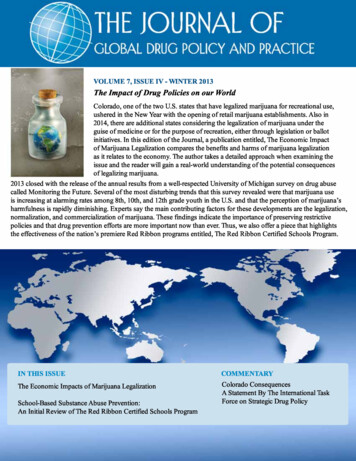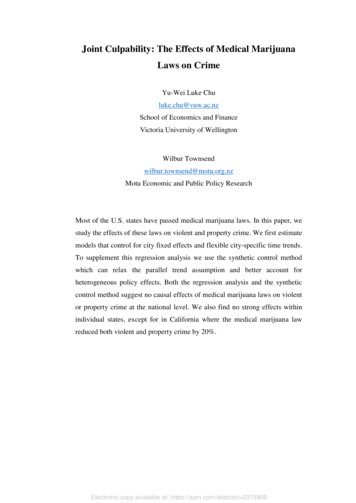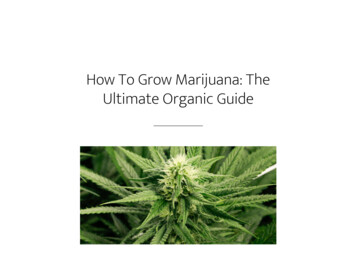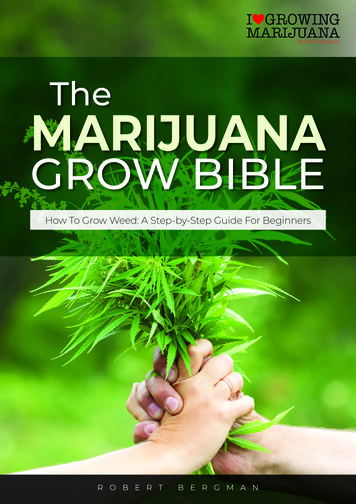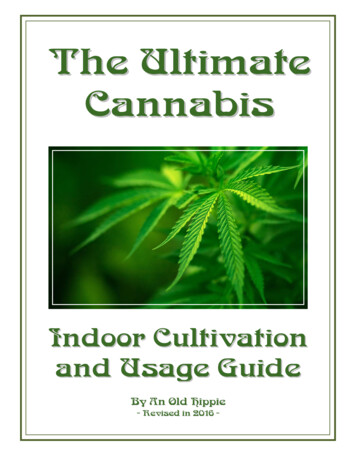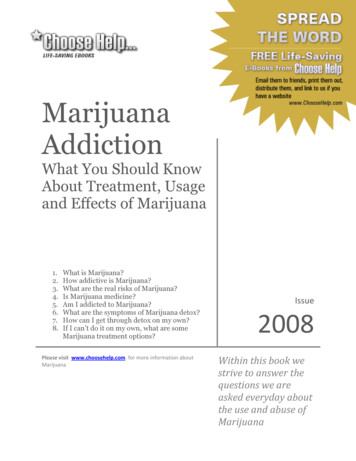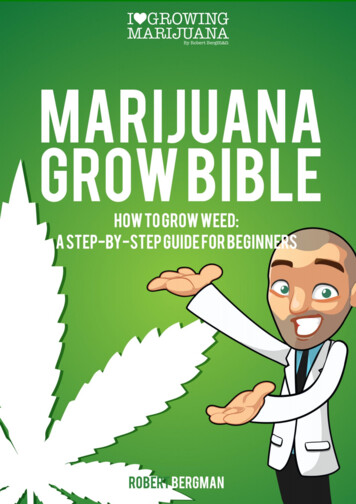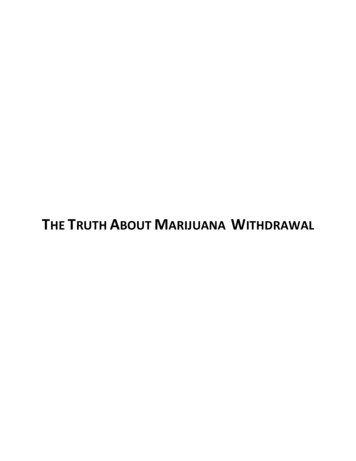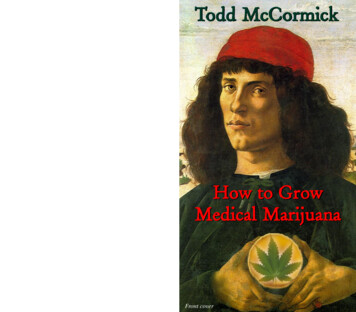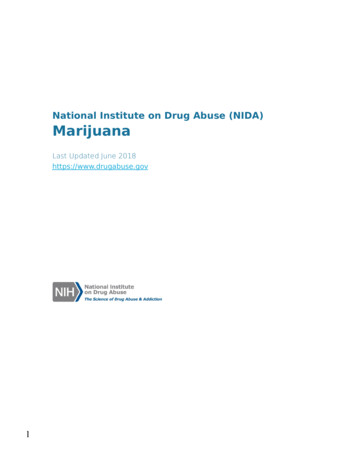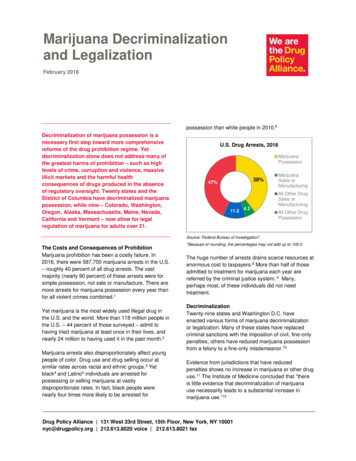
Transcription
Marijuana Decriminalizationand LegalizationFebruary 2018possession than white people in 2010.6Decriminalization of marijuana possession is anecessary first step toward more comprehensivereforms of the drug prohibition regime. Yetdecriminalization alone does not address many ofthe greatest harms of prohibition – such as highlevels of crime, corruption and violence, massiveillicit markets and the harmful healthconsequences of drugs produced in the absenceof regulatory oversight. Twenty states and theDistrict of Columbia have decriminalized marijuanapossession, while nine – Colorado, Washington,Oregon, Alaska, Massachusetts, Maine, Nevada,California and Vermont – now allow for legalregulation of marijuana for adults over 21.U.S. Drug Arrests, 2016MarijuanaPossession38%47%11.2 4.2MarijuanaSales orManufacturingAll Other DrugSales orManufacturingAll Other DrugPossessionSource: Federal Bureau of Investigation7,The Costs and Consequences of ProhibitionMarijuana prohibition has been a costly failure. In2016, there were 587,700 marijuana arrests in the U.S.– roughly 40 percent of all drug arrests. The vastmajority (nearly 90 percent) of these arrests were forsimple possession, not sale or manufacture. There aremore arrests for marijuana possession every year thanfor all violent crimes combined.1Yet marijuana is the most widely used illegal drug inthe U.S. and the world. More than 118 million people inthe U.S. – 44 percent of those surveyed – admit tohaving tried marijuana at least once in their lives, andnearly 24 million to having used it in the past month.2Marijuana arrests also disproportionately affect youngpeople of color. Drug use and drug selling occur atsimilar rates across racial and ethnic groups.3 Yetblack4 and Latino5 individuals are arrested forpossessing or selling marijuana at vastlydisproportionate rates. In fact, black people werenearly four times more likely to be arrested for*Because of rounding, the percentages may not add up to 100.0The huge number of arrests drains scarce resources atenormous cost to taxpayers.8 More than half of thoseadmitted to treatment for marijuana each year arereferred by the criminal justice system. 9 Many,perhaps most, of these individuals did not needtreatment.DecriminalizationTwenty-nine states and Washington D.C. haveenacted various forms of marijuana decriminalizationor legalization. Many of these states have replacedcriminal sanctions with the imposition of civil, fine-onlypenalties; others have reduced marijuana possessionfrom a felony to a fine-only misdemeanor.10Evidence from jurisdictions that have reducedpenalties shows no increase in marijuana or other druguse.11 The Institute of Medicine concluded that “thereis little evidence that decriminalization of marijuanause necessarily leads to a substantial increase inmarijuana use.”12Drug Policy Alliance 131 West 33rd Street, 15th Floor, New York, NY 10001nyc@drugpolicy.org 212.613.8020 voice 212.613.8021 fax
Where decriminalization has been implementedeffectively, it has resulted in substantial reductions inmisdemeanor marijuana arrests.13 In 2011, forexample, California reclassified marijuana possessionas an infraction (administrative violation) instead of amisdemeanor, leading to “a significant decline inmisdemeanor marijuana arrests,” which plunged from54,849 in 2010 to 7,764 in 2011 – a decrease of morethan 85 percent.14Why is Decriminalization Not Enough?Despite its benefits, decriminalization falls short inmany ways – largely because it still lies within theframework of prohibition. Consequently,decriminalization still suffers from the inherent harmsof prohibition – namely, an illegal, unregulated market;the unequal application of the laws (regardless ofseverity of penalty) toward certain groups, especiallypeople of color; and unregulated products of unknownpotency and quality.15Marijuana prohibition is unique among U.S.criminal laws – no other law is both enforced sowidely and harshly yet deemed unnecessary bysuch a substantial portion of the population.Under decriminalization, marijuana possession arrestsmay continue, or even increase, because police maybe more inclined to make arrests if they present lessadministrative burdens as infractions, civil offenses, oreven misdemeanors (without jail), as opposed tofelonies.16 Such a process – often called “netwidening” – occurred in parts of Australia thatdecriminalized marijuana,”17 as well as in states likeNew York and California, which reduced marijuanapenalties in the 1970s but ultimately saw certainmarijuana arrests increase.18A misdemeanor conviction, moreover, can seriouslyhinder an individual’s ability to succeed and participatein society by preventing him or her from obtainingemployment, housing and student loans. Even anarrest record can be an obstacle to opportunities forotherwise law-abiding individuals.19Additionally, not all decriminalization schemes protectall people from risk of arrest. Some states havedefined simple marijuana possession as only one-halfounce or even less; possession of more than theseamounts may still trigger harsh criminal penalties.Some states have only decriminalized a first offense,while subsequent offenses are punished severely.20In New York, personal marijuana possession isformally decriminalized, but possession in “public view”remains a crime. This loophole – coupled withpervasive and racially-biased over-policing of certaincommunities – has resulted in continued mass arrestsfor marijuana possession, overwhelmingly of black andLatino young men. The NYPD arrested nearly 17,00people21 for lowest-level marijuana possession in 2015– 85 percent of whom were black or Latino.22 Whilemarijuana arrests under New York City Mayor Bill deBlasio have declined significantly compared toprevious years, severe racial disparities remain.23Decriminalization will also do nothing to eliminate thelucrative underground market for marijuana, estimatedto be worth 40 billion or more in the U.S.24 Thisimmense market is completely untaxed, a source ofrevenue that federal and state governments can illafford to neglect.Instead, prohibition ensures that this vast marketenriches criminal organizations and contributes to highlevels of violence, crime and corruption.25 The effecthas been unending bloodshed in countries likeMexico,26 where at least 100,000 people have beenkilled in prohibition-related violence since 2007.27 TheU.S. government has asserted that “[M]arijuanadistribution in the United States remains the singlelargest source of revenue for Mexican [drug] cartels,”28and is “a cash crop that finances corruption and thecarnage of violence year after year.”29 Estimates byRAND Corporation and the Mexican Institute forCompetitiveness project that legalizing marijuananationally in the U.S. could reduce drug traffickingorganizations’ drug export revenues by between onefifth and one-third.30Taxation and RegulationLegal regulation is not a step into the unknown – wehave more than a century of experience in legallyregulating thousands of different drugs. Legalregulation means commonsense controls. Under mostregulatory proposals, marijuana would be taxed andregulated in a manner similar to alcoholic beverages,with age limits, licensing requirements, quality controls,and other regulatory restrictions.31 Just as cities,counties and states vary in the way they regulatealcohol, the same could be true for marijuana. Aregulated market will help protect consumer safety byrequiring that all marijuana products, includingmarijuana-infused products (“edibles”) andDrug Policy Alliance 131 West 33rd Street, 15th Floor, New York, NY 10001nyc@drugpolicy.org 212.613.8020 voice 212.613.8021 fax
Regulating marijuana will also help protect theenvironment. Illegal marijuana cultivation has adeleterious impact on the environment, from waterdiversion, pollution, energy usage to clandestine growoperations threatening public parks. Transitioning to alegal, regulated market will mitigate or alleviate manyof these environmental impacts of prohibition.32In 2012, Colorado and Washington became the firsttwo states – and first two places in the world – tolegalize marijuana for adult use. Two yearslater Alaska, Oregon and Washington, D.C.followedsuit. In 2016 voters in four additional states– California, Massachusetts, Maine and Nevada – alsoapproved ballot measures legalizing marijuana. InJanuary 2018, Vermont became the first state tolegalize marijuana through a state legislature. Morestates are expected to legalize in the near future.In Congress, Senator Cory Booker has introduced ahistoric legislation to end federal marijuana prohibitionin the senate and Senators Barbara Lee and RoKhanna have done so in the House ofRepresentatives.33 Each year since 2014, a bipartisanamendment passed by Congress has prohibited theDepartment of Justice from spending any money toprevent states "from implementing their own State lawsthat authorize the use, distribution, possession, orcultivation of medical marijuana."Internationally, Uruguay became the first country in theworld to legalize and regulate the marijuana trade in2013. Canada became the second country to do sopassed marijuana legalization in 2017. Additionallegalization proposals are under consideration inseveral other countries.Tax revenues in Colorado, Washington and Oregonhave all exceeded initial revenue estimates, totaling 552 million. This number is expected to increasesignificantly after the passing of legalization measuresin 2016, most notably in the nation’s most populousstate, California34.Public Support is Surging for LegalizationPublic support for making marijuana legal has shifteddramatically in the last two decades, with most pollsshowing greater than majority support nationwide.35Support for Reform NationwideDo you think the use of marijuana should be made legalor not? % No, illegal % Yes, legal84 81786670 70 73 7364 62 6460545044 4628 25 2523 253631 34 345850 5046 4858 606451473940 40 3612 15 200920102011201220132014201520162017concentrates, are tested for safety and quality; andlabelled with detailed information in child-proofpackaging. Such regulations will ensure thatconsumers are informed of the potency, recommendeddosage, and ingredients of all marijuana products andare educated on how to safely consume them – andkeep them out-of-reach of children.Source: Gallup October 19 2017.36States Don’t Need Federal Permission to LegalizeMarijuanaIn August of 2013, the Department of Justice (DOJ)announced that it will allow states to legally regulatethe production, distribution, and sale of marijuana. TheDOJ issued a directive to U.S. Attorneys, outliningfederal priorities for enforcing marijuana laws in statesthat have legalized. While reserving its right tochallenge state laws and enforce federal marijuanalaws under certain circumstances, the directive statesthat the federal government will coordinate with states,rather than seek to interfere, unless states fail to meetcertain federal priorities, such as preventing access byminors, diversion of marijuana, increases in violence ordrugged driving, or damage to public lands.In its memo, the DOJ openly acknowledged thatresponsible state marijuana regulations “mayaffirmatively address [federal] priorities by, forexample prevent[ing] diversion of marijuana outsideof the regulated system and to other states, prohibitingaccess to marijuana by minors, and replacing an illicitmarijuana trade that funds criminal enterprises with atightly regulated market.”37In early January 2018, the Attorney General JeffSessions announced that he would rescind theDrug Policy Alliance 131 West 33rd Street, 15th Floor, New York, NY 10001nyc@drugpolicy.org 212.613.8020 voice 212.613.8021 fax
Obama-era directive. However, states never neededpermission from the federal government to legalizemarijuana under state law. The memo merely offeredguidance to the state about federal enforcementpriorities. States are thus well within their 10thAmendment rights to legalize marijuana.at the local and state levels. The federal governmentmay be able to go after some individual marijuanabusinesses, but it has neither the political support northe resources to stamp out every marijuana businessoperating in compliance with state law.More than 90% of drug law enforcement is carried out1Federal Bureau of Investigation, "Crime in the United States, 2016,"(Washington, DC: U.S. Department of Justice, 2016).; Ingraham, Christopher“More people were arrested last year over pot than for murder, rape, aggravatedassault and robbery – combined”, Washington Post, September 26th, 20172Substance Abuse and Mental Health Services Administration, "Results from the2015 National Survey on Drug Use and Health: Detailed Tables," (Rockville, MD:Substance Abuse and Mental Health Services Administration, 2016), Table 1.33A& B.3American Civil Liberties Union, "The War on Marijuana in Black and White,"(2013); Ojmarrh Mitchell and Michael S. Caudy, "Race Differences in DrugOffending and Drug Distribution Arrests," Crime & Delinquency (2015); OjmarrhMitchell and Michael S Caudy, "Examining Racial Disparities in Drug Arrests,"Justice Quarterly (2013); Substance Abuse and Mental Health ServicesAdministration, "Results from the 2014 National Survey on Drug Use and Health:Detailed Tables," Table 1.19B.4American Civil Liberties Union, "The War on Marijuana in Black and White; HollyNguyen and Peter Reuter, "How Risky Is Marijuana Possession? Considering theRole of Age, Race, and Gender," Crime & Delinquency 58, no. 6 (2012); Harry G.Levine and Deborah P. Small, Marijuana Arrest Crusade: Racial Bias and PolicePolicy in New York City 1997-2007 (New York: New York Civil Liberties Union,2008); A. Golub, B.D. Johnson, and E. Dunlap, "The Race/Ethnicity Disparity inMisdemeanor Marijuana Arrests in New York City*," Criminology & public policy 6,no. 1 (2007).5National arrest data by ethnicity are not collected systematically and aretherefore incomplete, but state-level data show that Latinos are indeeddisproportionately arrested for marijuana possession. See California Departmentof Justice, "Crime in California 2012," (2013); Harry Levine, Loren Siegel, andGabriel Sayegh, "One Million Police Hours: Making 440,000 Marijuana PossessionArrests In New York City, 2002‐2012," (New York: Drug Policy Alliance, 2013).6American Civil Liberties Union, "The War on Marijuana in Black and White."7“2016 Crime in the United States,” U.S. Department of Justice, Federal Bureauof Investigation Uniform Crime Report, Criminal Justice Information /crime-in-the-u.s.-2016; Data obtainedthrough a request to the FBI8Ibid; Jeffrey A Miron and Katherine Waldock, The Budgetary Impact of EndingDrug Prohibition (Cato Institute, 2010).9Substance Abuse and Mental Health Services Administration Center forBehavioral Health Statistics and Quality, "Treatment Episode Data Set (TEDS)2002-2012: National Admissions to Substance Abuse Treatment Services,"(Rockville, MD: Substance Abuse and Mental Health Services Administration,2014), Table 2.6.10Ten states (Connecticut, Delaware, Maine, Maryland, Massachusetts,Mississippi, Nebraska, New York, Rhode Island, and Vermont) consider simplepossession of marijuana as an administrative or civil infraction. Four states(Minnesota, Missouri, North Carolina, and Ohio) treat marijuana possession as amisdemeanor without jail time. And eight states (Oregon, Alaska, Washington,Colorado, California, Massachusetts, Maine and Nevada) plus Washington D.C.have completely eliminated all penalties for personal marijuana possession byadults.11Robin Room et al., Cannabis policy: moving beyond stalemate (OxfordUniversity Press, USA, 2010); Eric W Single, "The impact of marijuanadecriminalization: an update," Journal of public health policy (1989); Clifford F.Thies and Charles A. Register, "Decriminalization of marijuana and the demand foralcohol, marijuana and cocaine," The Social Science Journal 30, no. 4 (1993);Organization of American States, "Scenarios for the Drug Problem in theAmericas: 2013-2025," rios Report.PDF; Caitlin ElizabethHughes and Alex Stevens, "What Can We Learn From The PortugueseDecriminalization of Illicit Drugs?," British Journal of Criminology 50, no. 6 (2010);Louisa Degenhardt et al., "Toward a global view of alcohol, tobacco, cannabis,and cocaine use: findings from the WHO World Mental Health Surveys," PLoSmedicine 5, no. 7 (2008); S. Ammerman et al., "The Impact of Marijuana Policieson Youth: Clinical, Research, and Legal Update," Pediatrics (2015).12Janet Elizabeth Joy, Stanley J Watson, and John A Benson, Marijuana andmedicine: assessing the science base.13Mike Males and Lizzie Buchen, "Reforming marijuana laws: Which approachbest reduces the harms of criminalization? A Five-State Analysis," (San Francisco:Center on Juvenile and Criminal Justice, cj marijuana reform comparison.pdf.14Bureau of Criminal Statistics California Department of Justice, "Crime inCalifornia 2011," (2012); California Department of Justice, "Crime in California2012; California Department of Justice, "Crime in California 2013," (2014).15Jennifer McLaren et al., "Cannabis potency and contamination: a review of theliterature," Addiction 103, no. 7 (2008); Nicholas Sullivan, Sytze Elzinga, andJeffrey C Raber, "Determination of pesticide residues in cannabis smoke," Journalof toxicology 2013(2013).16Aldrich, M. et al., Fiscal Savings in California Marijuana Law Enforcement, 19761985 Attributable to the Moscone Act of 1976 (1986).17Peter Reuter, "Marijuana Legalization: what can be learned from othercountries," (Santa Monica, CA: RAND, 2010), 9.18See, e.g., Michael R Aldrich and Tod Mikuriya, "Savings in California marijuanalaw enforcement costs attributable to the Moscone Act of 1976—A summary,"Journal of Psychoactive Drugs 20, no. 1 (1988); Levine and Small, MarijuanaArrest Crusade: Racial Bias and Police Policy in New York City 1997-2007; Single,"The impact of marijuana decriminalization: an update; Eric Single, Paul Christie,and Robert Ali, "The impact of cannabis decriminalisation in Australia and theUnited States," Journal of public health policy (2000).19Babe Howell, "Broken Lives from Broken Windows: The Hidden Costs ofAggressive Order-Maintenance Policing," New York University Review of Law &Social Change 33(2009); Richard Glen Boire, Life Sentences: Collateral SanctionsAssociated with Marijuana Offenses (Center for Cognitive Liberty & Ethics, 2007);American Civil Liberties Union, "The War on Marijuana in Black and White."20See e.g., NORML, “State Laws,” http://norml.org/laws.21Mel Evans, “Still Too High? Marijuana Arrests Barely Budge in NYC,” WNYC,January 16, 2018, a-arrestsbarely-budge-nyc/22Marijuana Arrest Research Project and Drug Policy Alliance, “Unjust andConstitutional: 60,000 Jim Crow Marijuana Arrests in Mayor de Blasio's New York,The NYPD's Racially-Targeted Enforcement of Marijuana Possession Continues,2014 – 2016” 17 2.pdf23Drug Policy Alliance and Marijuana Arrest Research Project, "Race, Class andMarijuana Arrests in Mayor de Blasio's Two New Yorks: the N.Y.P.D.'s MarijuanaArrest Crusade Continues in 2014," rks-nypds-marijuana-arrest-crus; Harry Levine and LorenSiegel, "80 Marijuana Possession Arrests a Day is More of the Same: NYPD dailymarijuana possession arrest numbers are the same under de Blasio and Brattonas they were under Bloomberg and Kelly," (Marijuana Arrest Research Project,2014) --NYC-MarijuanaArrests-June2014.pdf.; Marijuana Arrest Research Project and Drug PolicyAlliance, “Unjust and Constitutional: 60,000 Jim Crow Marijuana Arrests in Mayorde Blasio's New York, The NYPD's Racially-Targeted Enforcement of MarijuanaPossession Continues, 2014 – -July2017 2.pdf24Beau Kilmer et al., "What America’s users spend on illicit drugs: 2000-2010,"(Washington, D.C.: Office of National Drug Control Policy, /page/files/wausid report final 1.pdf.25Peter Reuter, "Why Has US Drug Policy Changed So Little over 30 Years?,"Crime and Justice 42, no. 1 (2013).26Ibid.27"México reporta 150 mil ejecuciones producto del narcotráfico," TeleSUR, April14 2013 2013; Instituto Nacional de Estadística y Geografía (INEGI), "Banco deDatos: Defunciones por Homicidio," (INEGI, d 6300000264; Molly Molloy, "PeñaNieto’s First Year: Iraq on Our Southern Border," Small Wars Journal (2014);Proceso, "Más de 121 mil muertos, el saldo de la narcoguerra de Calderón:INEGI," Proceso, July 30 2014; Rafael Romo, "Mexican drug lord: Inside hisabandoned mansion," CNN.com, February 6 2014.28David G. Ogden, "Memorandum for Selected United States Attorneys.Investigations and Prosecutions in States Authorizing the Medical Use ofMarijuana," (Office of the Deputy U.S. Attorney General, 2009).29Kevin L. Perkins and Anthony P. Placido, "Drug Trafficking Violence in Mexico:Implications for the United States," in Statement for the Record of Kevin L.Perkins, Assistant Director, Criminal Investigative Division, FBI; and Anthony P.Placido, Assistant Administrator for Intelligence, DEA, Before the U.S. SenateCaucus on International Narcotics Control, May 5, 2010. (U.S. Senate Caucus onInternational Narcotics Control., 2010).30Beau Kilmer et al., Reducing drug trafficking revenues and violence in Mexico:Would Legalizing Marijuana in California Help? (Santa Monica: RANDCorporation, 2010); Alejandro Hope and Eduardo Clark, "Si los vecinos legalizan:Reporte técnico," (Instituto Mexicano para la Competitividad (IMCO), 2012).31Jonathan P Caulkins et al., "Design considerations for legalizing cannabis:lessons inspired by analysis of California's Proposition 19," Addiction (2012).32Warren, Gina S., Regulating Pot to Save the Polar Bear: Energy and ClimateImpacts of the Marijuana Industry (September 24, 2014). Columbia Journal ofEnvironmental Law Vol. 40, No. 3, http://ssrn.com/abstract 2501126.Drug Policy Alliance 131 West 33rd Street, 15th Floor, New York, NY 10001nyc@drugpolicy.org 212.613.8020 voice 212.613.8021 fax
33Drug Policy Alliance, "Senator Cory Booker Introduces Marijuana LegalizationBill, focused on Racial Justice" -billfocused-racial.34Drug Policy Alliance, “So Far So Good: What We Know About MarijuanaLegalization in Colorado, Washington, Alazka, Oregon and Washington D.C.”(2016)35Art Swift, "Support for Legal Marijuana Use Up to 60% in U.S.," Gallup, October19 2016; Pew Research Center, "In Debate Over Legalizing Marijuana,Disagreement Over Drug’s Dangers; In Their Own Words: Supporters andOpponents of Legalization," Pew Research Center, April 15 2015; ChristopherIngraham, "A majority favors marijuana legalization for first time, according tonation’s most authoritative survey," Washington Post, March 4, 2015.36Justic McCarthy, "Record-High Support for Legalizing Marijuana Use in U.S.,"Gallup, October 25th 2017.37James Cole, "Memorandum for all United States Attorneys: GuidanceRegarding Marijuana Enforcement," (Washington, DC: U.S. Department of Justice,Office of the Deputy Attorney General, 2013).Drug Policy Alliance 131 West 33rd Street, 15th Floor, New York, NY 10001nyc@drugpolicy.org 212.613.8020 voice 212.613.8021 fax
Yet marijuana is the most widely used illegal drug in the U.S. and the world. More than 118 million people in the U.S. – 44 percent of those surveyed – admit to having tried marijuana at least once in their lives, and nearly 24 million to having used it in the past month.2 Marijuana arre

